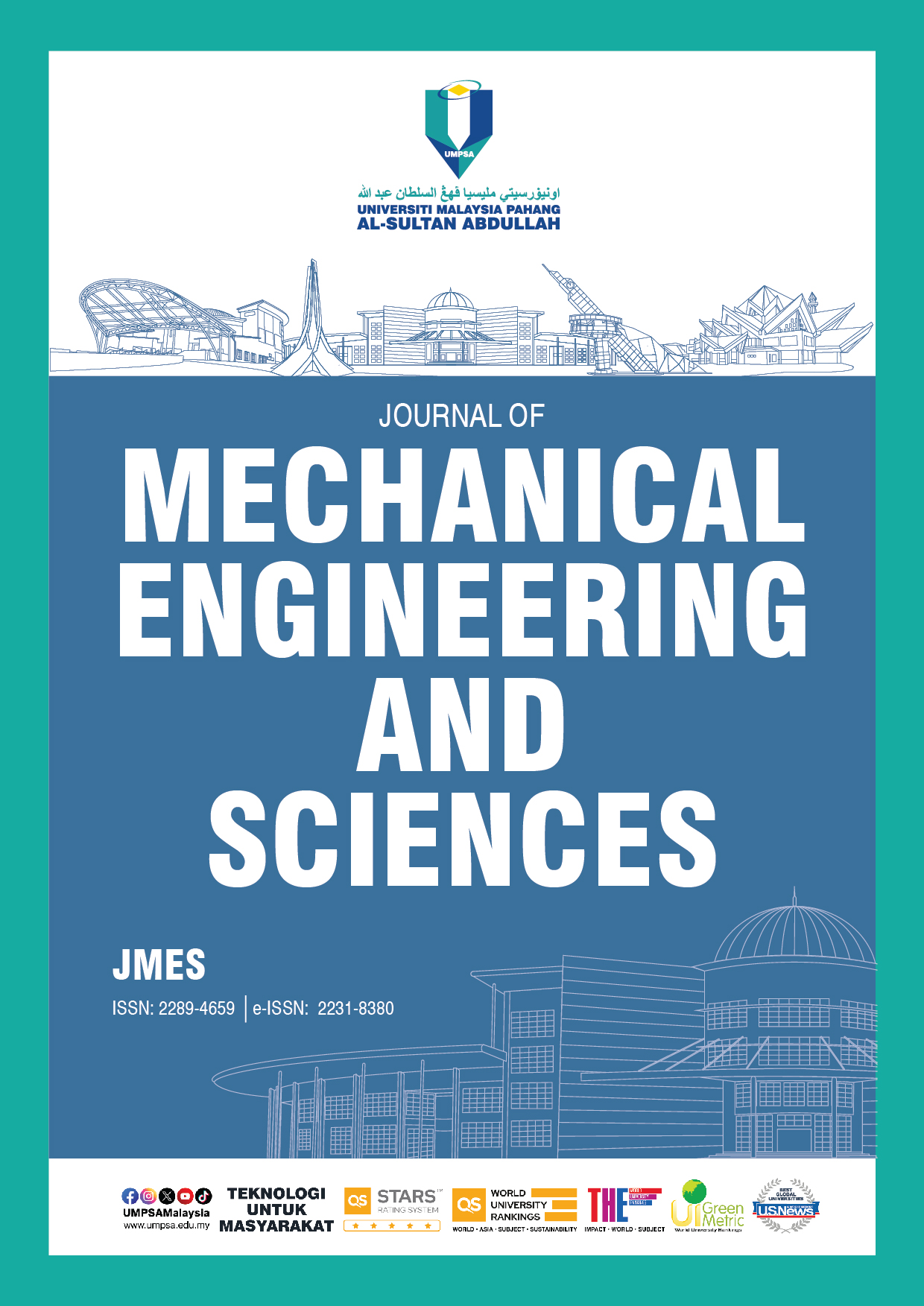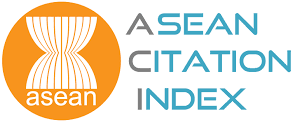Impact of eave and roof pitch on cross ventilation for an isolated building with sawtooth roof
DOI:
https://doi.org/10.15282/jmes.17.2.2023.6.0750Keywords:
eave inclination, roof pitch, cross ventilation, CFD, ventilation rateAbstract
An eave refers to an extension attached to the building roof to protect the interior space from direct solar radiation and improve the performance on cross ventilation. In this study, the impact of eave inclination angle and roof pitch of an isolated sawtooth roof building on cross ventilation were investigated. The eave configurations at either windward or leeward openings were included. 3D steady Reynolds-Averaged Navier-Stokes (RANS) equation in combination with the Shear-Stress Transport model (SST k-ω model) was used for the Computational Fluid Dynamics (CFD) simulations. Grid sensitivity study was carried out and the performance of cross ventilation was evaluated based on the non-dimensional velocity magnitude, spatial distribution of pressure coefficient as well as the ventilation rate of the building. For the simulation model with 55° roof pitch, it is observed that a region with high velocity magnitude formed on top of the leeward eave due to the higher roof pitch and presence of the leeward eave. Results also indicated that the building model with 90° leeward eave and 55° roof pitch has the highest increment in ventilation rate which is 7.16%. On the other hand, the building model with 90° windward eave has the highest pressure coefficient because more blockage of airflow is caused by a steeper roof as the roof pitch of the building increases. Furthermore, the building model with 90° leeward eave shows a larger region with negative pressure at the leeward façade indicating higher airflow leaving the leeward opening. Therefore, the airflow behavior and characteristic are both dependent on the roof pitch and eave inclination angle for a naturally ventilated building.
References
C. H. Lim, S. Omidreza, S. Kamaruzzaman, M. Y. Sulaiman, M. Sohif, S. Elias, and K.C. Ng, “Design configurations analysis of wind-induced natural ventilation tower in hot humid climate using computational fluid dynamics,” International Journal of Low-Carbon Technologies, vol. 10, no. 4, pp. 332–346, 2015.
Energy Data and Research Unit, Malaysia Energy Statistics Handbook, Putrajaya, Malaysia: Suruhanjaya Tenaga (Energy Commission), pp. 86, 2020, [Online]. Available: www.st.gov.my
L. K. Moey, N. M. Adam, K. A. Ahmad, and L. C. Abdullah, “Wind tunnel study of different roof geometry configurations for wind induced natural ventilation into stairwell in tropical climate,” International Journal of Applied Engineering Research, vol. 13, no. 5, pp. 2635–2647, 2018.
G. K. Ntinas, X. Shen, Y. Wang, and G. Zhang, “Evaluation of CFD turbulence models for simulating external airflow around varied building roof with wind tunnel experiment,” Building Simulation, vol. 11, pp. 115-123, 2018.
P. H. V. Nimarshana , R. A. Attalage, and K. K. C. Perera, “Quantification of the impact of RANS turbulence models on airflow distribution in horizontal planes of a generic building under cross-ventilation for prediction of indoor thermal comfort,” Journal of Building Engineering, vol. 52, pp. 104409, 2022.
N. Nasrollahi and P. Ghobadi, “Field measurement and numerical investigation of natural cross-ventilation in high-rise buildings; Thermal comfort analysis, ” Applied Thermal Engineering,vol. 211, pp. 118500, 2022.
J. I. Perén , T. van Hooff, R. Ramponi, B. Blocken, and B. C. C. Leite, “Impact of roof geometry of an isolated leeward sawtooth roof building on cross-ventilation: Straight, concave, hybrid or convex?,” Journal of Wind Engineering and Industrial Aerodynamics, vol. 145, pp. 102–114, 2015.
C. R. Chu and B. F. Chiang, “Wind-driven cross ventilation with internal obstacles,” Energy and Buildings, vol. 67, pp. 201–209, 2013.
L. K. Moey, M. F. Kong, V. C. Tai, T. F. Go, and N. M. Adam, “Effect of Gable roof angle on natural ventilation for an isolated building,” Jordan Journal of Mechanical & Industrial Engineering, vol. 15, no. 3, pp. 291–300, 2021.
J. I. Perén, T. van Hooff, B. C. C. Leite, and B. Blocken, “Impact of eaves on cross-ventilation of a generic isolated leeward sawtooth roof building: Windward eaves, leeward eaves and eaves inclination,” Building and Environment, vol. 92, pp. 578–590, 2015.
J. I. Perén, T. Van Hooff, B. C. C. Leite, and B. Blocken, “CFD simulation of wind-driven upward cross ventilation and its enhancement in long buildings: Impact of single-span versus double-span leeward sawtooth roof and opening ratio,” Building and Environment, vol. 96, pp. 142-156, 2015.
B. Cui, "Wind effects on monosloped and sawtooth roofs," Ph.D Thesis, Clemson University, 2007.
C. Li, Y. Han, J. Zhang, S. Liu, and C. S. Cai, “Wind tunnel tests on wind pressure characteristics of sawtooth roofs, ” Journal of Aerospace Engineering,vol. 31, no. 6, pp. 04018107, 2018.
O. H. Al-Aghbari, L. K. Moey, V. C. Tai, T. F. Go, and M. H. Yazdi, “Study on the impact of sawtooth roof inclination angles and asymmetrical opening positions for an isolated building in cross ventilation, ” Jordan Journal of Mechanical & Industrial Engineering, vol.16, no. 5, pp. 865-878, 2022.
P. Karava, T. Stathopoulos, and A. K. Athienitis, “Airflow assessment in cross-ventilated buildings with operable façade elements,” Building and environment, vol. 46, no. 1, pp. 266–279, 2011.
J. Franke, A. Hellsten, H. Schlünzen, and B. Carissimo, “Best practice guideline for the CFD simulation of flows in the urban environment,” COST Action, vol. 44, pp. 1–52, 2007.
Y. Tominaga, A. Mochida, R. Yoshie, H. Kataoka, T. Nozu, M. Yoshikawa, and T. Shirasawa, “AIJ guidelines for practical applications of CFD to pedestrian wind environment around buildings,” Journal of Wind Engineering and Industrial Aerodynamics, vol. 96, no. 10–11, pp. 1749–1761, 2008.
R. Ramponi and B. Blocken, “CFD simulation of cross-ventilation for a generic isolated building: Impact of computational parameters,” Building and Environment, vol. 53, pp. 34–48, 2012.
K. Zore, B. Sasanapuri, G. Parkhi, and A. Varghese, “Ansys mosaic poly-hexcore mesh for high-lift aircraft configuration,” 21st Annual CFD Symposium, Bangalore, August 2019.
P. Karava, "Airflow prediction in buildings for natural ventilation design: Wind tunnel measurements and simulation," Ph.D Thesis, Concordia University, 2008.
R. Ramponi and B. Blocken, “CFD simulation of cross-ventilation flow for different isolated building configurations: Validation with wind tunnel measurements and analysis of physical and numerical diffusion effects,” Journal of Wind Engineering and Industrial Aerodynamics, vol. 104–106, pp. 408–418, 2012.
Y. Tominaga, S. ichi Akabayashi, T. Kitahara, and Y. Arinami, “Air flow around isolated gable-roof buildings with different roof pitches: Wind tunnel experiments and CFD simulations,” Building and Environment, vol. 84, pp. 204–213, 2015.
B. E. Launder and D. B. Spalding, “The numerical computation of turbulent flows,” Computer Methods in Applied Mechanics and Engineering, vol. 3, no. 2, pp. 269–289, 1974.
T. Cebeci and P. Bradshaw, "Momentum transfer in boundary layers," New York: Hemisphere Publishing Corporation, 1977.
M. Swami and S. Chandra, “Procedures for calculating natural ventilation airflow rates in buildings,” ASHRAE Final Report FSEC-CR-163-86, 1987.
Downloads
Published
Issue
Section
License
Copyright (c) 2023 Universiti Malaysia Pahang Publishing

This work is licensed under a Creative Commons Attribution-NonCommercial 4.0 International License.






